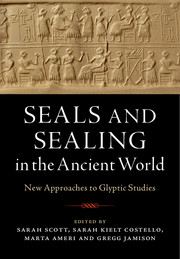 Seals and Sealing in the Ancient World
Seals and Sealing in the Ancient World Book contents
- Seals and Sealing in the Ancient World
- Seals and Sealing in the Ancient World
- Copyright page
- Contents
- Notes on Contributors
- Illustrations
- Plates
- Tables
- Acknowledgments
- Preface
- Abbreviations
- Chapter One Introduction: Small Windows, Wide Views
- Part I The Ancient Near East and Cyprus
- Part II South Asia and the Gulf Region
- Part III Egypt
- Part IV Aegean
- References
- Endnotes
- Index
Part IV - Aegean
Published online by Cambridge University Press: 24 April 2018
- Seals and Sealing in the Ancient World
- Seals and Sealing in the Ancient World
- Copyright page
- Contents
- Notes on Contributors
- Illustrations
- Plates
- Tables
- Acknowledgments
- Preface
- Abbreviations
- Chapter One Introduction: Small Windows, Wide Views
- Part I The Ancient Near East and Cyprus
- Part II South Asia and the Gulf Region
- Part III Egypt
- Part IV Aegean
- References
- Endnotes
- Index
Summary
Aegean scholars have recently completed fifty years of glyptic codification with the Corpus der minoischen und mykenischen Siegel (CMS), which means that virtually all Aegean seals and sealings are now recorded and classified. Originally, the study of Aegean glyptic focused almost exclusively on seals as art-historical documents, while the Corpus now encourages both systematic studies of glyptic chronology and a more refined analysis of technical developments. Another area of research especially pertinent to the pre- and proto-literate Aegean is the function of seals as “badges” for specific socio-economic groups. There is furthermore a pronounced shift to the study of the use of seals and the role of sealings in palatial economic and administrative systems. The research pendulum is swinging once again with a new emphasis on the amuletic and magical properties of seals, gender-specific seal iconography, and the activities of particular glyptic groups.
- Type
- Chapter
- Information
- Seals and Sealing in the Ancient WorldCase Studies from the Near East, Egypt, the Aegean, and South Asia, pp. 325 - 400Publisher: Cambridge University PressPrint publication year: 2018
